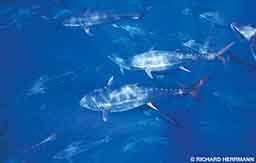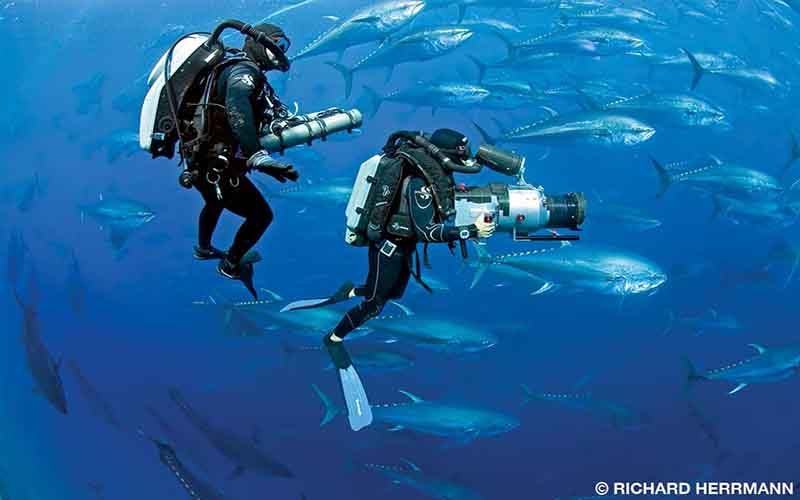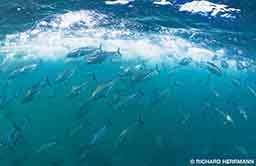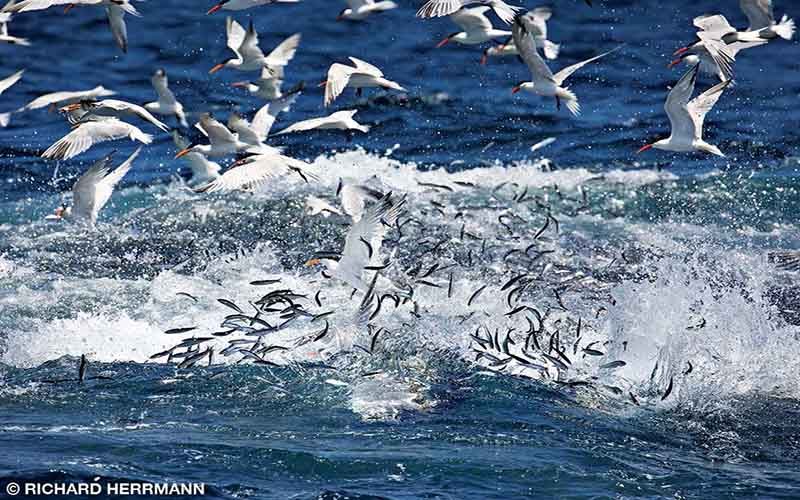While most fish can remain motionless and respire by opening and closing their mouths to pass water through their gills, tuna do not have the ability to do that. Larger tunas are warm-blooded and have “mega-gills,” which may be 10 times the size of cold-blooded fishes’ gills. This adaptation requires consistent passage of a very large volume of water through the gills. The warm blood comes from vascular heat exchangers that maintain a temperature in selected body regions that is higher than the ambient water temperature. This physiological feature gives tuna a speed advantage over their prey and warms the cold water that passes through the gills during cruising. Tuna can also use vascular activity to dissipate heat to the surrounding water to prevent overheating during feeding activity.
My personal history with tuna began when I started taking underwater photos about 35 years ago. At the time there were few images of tuna in the wild. One day in the early 1980s after I had been diving on a drifting kelp paddy off the California coast, I watched as a school of 60-pound Pacific bluefin tuna arose from the depths to feed on a school of baitfish that was swimming below me. The speed and ferocity of the attack impressed me, and I began dreaming about capturing tuna on film. Although I had photographed some hooked tuna for fishing magazines, getting photos in the wild seemed like a long shot.

At first the best photo opportunities I could get were in grow-out pens of Pacific bluefin tuna destined for the Japanese sushi market. I got myself into the nets early in the pen-raised era and could for the first time get really close to the fish. In 2007 I was working on the Disney film Oceans and got to do an Atlantic bluefin tuna photo shoot in the Mediterranean. For the first time I saw what a 1,000-pound tuna looks like underwater. Nothing can prepare you for the experience of swimming among such massive giants. The huge bluefin seemed like Volkswagen buses swimming by me.
Yellowfin, albacore and skipjack have long been targeted for canned tuna, but in recent years the bluefin has become the real “cash cow.” There are three species of bluefin tuna: the southern bluefin tuna (Thunnus maccoyii) from the Southern Hemisphere, the Atlantic bluefin tuna (Thunnus thynnus) and the Pacific bluefin tuna (Thunnus orientalis). All three species are captured in the wild and raised in grow-out pens for later harvesting.
Japan consumes about 80 percent of commercially distributed bluefin tuna, and prices have undergone massive hikes in the past decade. A single 489-pound bluefin tuna fetched $1.76 million in 2013. These bluefin tuna are the same fish that were popularly called “horse mackerel” and were used for cat food and fertilizer in the 1950s and 1960s. Because of the price increase, fishing pressure has increased exponentially, especially on Atlantic bluefin tuna in their spawning grounds in the Mediterranean.

The environmental impact of this demand has been such that today the Atlantic bluefin is listed as endangered on the International Union for Conservation of Nature (IUCN) Red List of Threatened Species. Recent research shows that Pacific bluefin tuna stocks are at 2.6 percent of the prefished biomass levels. These same studies warn that the existing take rates for Pacific bluefin are not sustainable. Bluefin conservation is the subject of much controversy between commercial interests and the scientific community.
In 2016 I was part of a Silverback Films crew documenting Pacific bluefin tuna off the Southern California coast. We spent 20 days looking for tuna using spotter planes, the best intelligence available from the sport fishing industry and — perhaps the most important factor — signs the ocean provided us. These signs included subtle surface ripples made by traveling fish, indicator birds and fish feeding on the surface. On a good day, a seemingly endless glassy surface would suddenly explode with feeding tuna, at which point we would race to the action with the world’s most cutting-edge filming technology, capturing the activity from the surface to the depths.

The only time divers can closely observe tuna in the wild is when they are feeding, although “exploding” may be a more descriptive term. The foaming water, scales, blood and mayhem produced by feeding tuna is truly one of nature’s great events. Sometimes, if the wind is just right, you might even smell the frenzy before you see it. Joining this activity is not without some risk. Filmmaker David Reichert was filming a baitball with large yellowfin tuna crashing on it, when two beach-ball-sized portions of the bait broke off and hid on him and his gear. Soon 100-pound yellowfin were pounding the bait right off his body. No matter how hard he tried, Reichert could not shake the baitfish. After taking some pretty nasty glancing blows, he finally was able to escape. Obviously, a direct shot from a 100-pound fish-missile going 30 knots is not good.
So where does one go to find tuna? Any offshore high spot or open-sea pelagic excursion carries the possibility, and sometimes large tuna will come to bait. I have taken some wonderful images of yellowfin tuna from inside a cage at Guadalupe Island, Mexico, while photographing white sharks. I have also seen some great images from South Africa during baiting operations for yellowfin and albacore. Huge Atlantic bluefin are mainly seen in waters off Cape Cod, Maine, Nova Scotia, Scotland and in the Mediterranean. A few pen operations in Australia and Baja California are also starting to incorporate ecotours that allow snorkelers into the pens for a close look at Pacific and southern bluefin tuna.

indicators of tuna predation in the wild.
As with sharks, billfish and the world’s other great pelagic fishes, it will be interesting to see how we manage tuna populations in coming years. These beautiful, specialized fish help maintain the ecological balance in tropical and temperate seas of the world. We need them for food, but we also need healthy populations in the wild for the benefit of future generations.
| © Alert Diver — Q1 2018 |
|---|
| © Alert Diver — Q1 2018 |